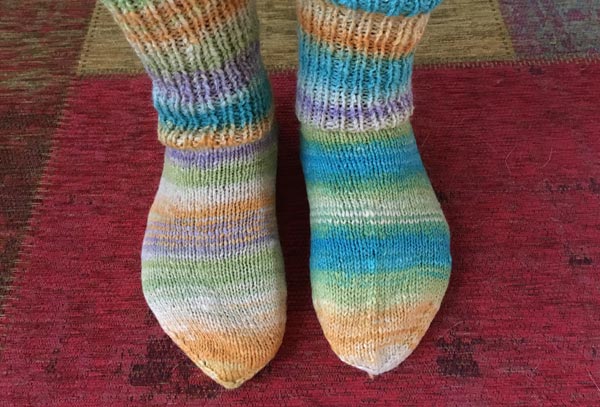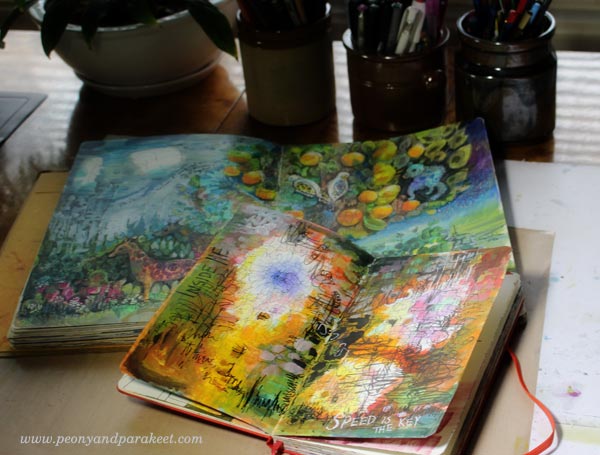Get Intuitive Focus + Reader’s Comment!

“I am all over the place. I need to focus”.
It’s what I often hear when people talk about their creativity.
I used to scold myself there too. After a quilting class, I swore I would use all my creative time to modern quilting only. But after finishing one quilt project, I was ready to knit again. I questioned myself when I drew because I had just made a promise to focus on painting. I found it impossible to stick to one style or one genre of creating, and I saw that as my worst weakness.

But the more I have been into intuitive art, the more I have realized that creative people often underestimate the connections between what they do. The more conscious I have become about how my creative process works, the less I need to criticize my natural behavior.
4 Ways of Creating
I classify creating as:
– reflecting by creating
– generating ideas by creating
– imagining by creating
– and finally, focusing on the insight you’ve got by creating
If I write about past events in my planner or knit, it’s reflecting. When I get ideas, I create art journal pages or quick craft projects. With a collection of ideas, I can gradually gear my imagination towards the bigger themes that I want to express.
When I create just to save my ideas, I don’t work for hours to get everything right. It’s a piece that had to be created so that I can move on. But when I am creating a bigger project, like my big canvas painting last week, I fine-tune every little detail and put a lot more time into the project.
What Does Intuitive Focus Mean?
Intuitive focus means that you treat your activities as part of creative process. You continuously collect and process theories, techniques, ideas, approaches so that you can create your best pieces now and then. You embrace diversity in techniques, themes, styles, etc. Diversity will not be distracting if you spend enough time for reflecting.

Once you do this, you will get in touch with your root problems:
Your lack of focus on one activity or idea turns into a lack of ways to combine it all together.
Your lack of focus on one technique turns into a lack of foundation that can be applied to many techniques.
Teaching Art – Reader’s Comment
In my last weekly email (do subscribe!) I wrote about whether teachers share openly or not and why would they not:
“Last week, I read a comment somewhere on the internet. It praised a teacher about sharing openly. The commenter also said that she often gets the feeling that teachers hide something. Even if this was not about any of my classes it made me think. Do I share openly? Why would a teacher not share openly? When building classes, I try to focus on the essentials and be understandable, clear and not all over the place. That’s good, right?”
“But when teaching intuitive art, I have to admit that almost anything can be meaningful to the process. A random thought can steer the painting to a new direction. So I decided to add more video to my next class Nature in Your Mind showing how I ramble while creating and how it affects my painting. I also show how I use music to help me let go. While recording, I felt vulnerable. Every time I became silent, I forced myself to ask: what did I just think? There’s also the pressure of time. I can’t create for 7 hours and then make an educational video out of that.”
“So I have to choose smaller projects for the exercises and recordings. But truly, I don’t intentionally hide anything. I don’t think many teachers do. For some, explaining is more difficult than for others. Some find it difficult to give honest feedback. When I started teaching, I made a promise always to give as useful and as personalized feedback as possible while the workshop is running. For many, understanding the slight changes they can make is a game changer. It’s a pity if the teacher never points out those. Probably that’s the situation when the teacher seems to be hiding something. What do you think?”
Meri Andriesse wrote to me as a response to the email:
“I sign up for a lot of workshops in painting and mixed media and I find they vary greatly in content. To be honest, I don’t think some teachers have enough substantive content in their classes and they rush through without explaining why they are doing or not going or un-doing something. So much of what we see and hear focuses on the intuitive part of creativity but I think in order to use intuition you really need some foundation in composition and color theory/experimentation. Your workshops offer that and more and that is why I continue to sign up for them even though I don’t have adequate free time for art making.”
Teaching art is often based on process videos only. Meri comments that too:
“Videos are great, but I also appreciate the pdf documents and diagrams and photos. I wouldn’t hesitate to recommend your classes to anyone really interested in growing their art-making.”
Create intuitive art + set a foundation for your creating!
>> Sign up for Nature in Your Mind!
This is the last chance to register! The registration will close on Oct 10th midnight PST.
2 thoughts on “Get Intuitive Focus + Reader’s Comment!”
Comments are closed.
Comments like that: it is the most rewarding thing to get from your students, isn’t it? As a teacher, I teach techniques and theory as a ‘base’ so that students can build on that to go loose in their own style. And I agree on giving feedback to your students: be nice but critical, they learn from that way more than from nice comments (‘awesome’) only… (Oh my, I wish English was my mother language ’cause I would love to ‘talk’ to you about this topic more, but I find it hard to explain my thoughts in English – it’s a bit telegram style now and I don’t know if I can bring across what I really mean..) Anyway, thanks for your post. Have a great weekend. Love from Holland.
Thank you for your comment, Marit!